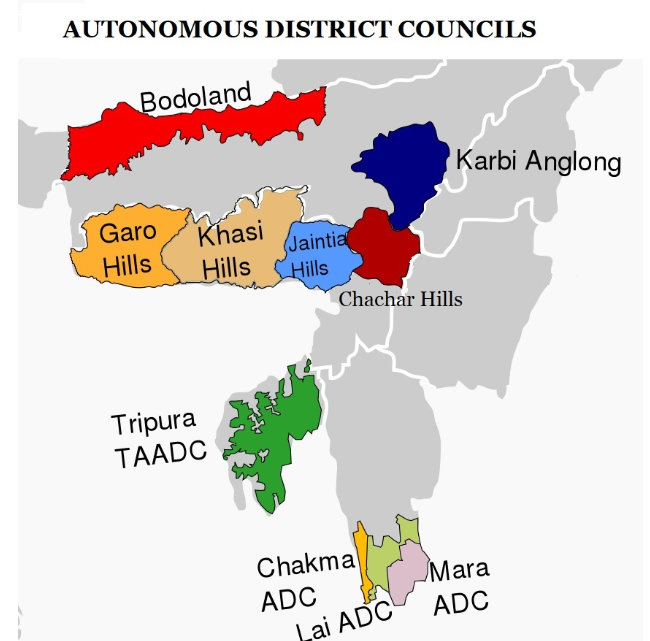-
Q. “The Sixth Schedule of the Indian Constitution provides autonomy to certain regions but has also posed challenges in governance”. Discuss the relevance of the Sixth Schedule in contemporary India. (250 words)
04 Feb, 2025 GS Paper 2 Polity & GovernanceApproach
- Introduce the answer by briefing about Sixth Schedule and delve into the Autonomy Granted by it
- Highlight the Challenges in Governance Under the Sixth Schedule
- Give Relevance of the Sixth Schedule in Contemporary India
- Suggest Measures to Align Relevance of Sixth Schedule with Evolving Needs
- Conclude the answer with a forward looking approach.
Introduction
The Sixth Schedule of the Constitution of India is based on the reports of the Bordoloi Committee formed by the Constituent Assembly. Under Article 244(2), the Sixth Schedule grants autonomy to tribal areas in Assam, Meghalaya, Tripura, and Mizoram through ADCs, safeguarding tribal rights and cultural identity.
Body
Autonomy Granted by the Sixth Schedule:
- Self-Governance through ADCs: Autonomous District Councils (ADCs) have legislative, executive, and judicial powers to govern key areas such as land, forests (excluding reserved forests), inheritance, and administration of justice.
- Decentralized Governance: Empowers local tribal bodies to administer development activities, revenue collection, and regulation of trade within their jurisdiction. (e.g., Bodoland Territorial Council managing local education and welfare schemes)
- Special Provisions for Development – The Schedule allows the Governor to modify or exempt laws, ensuring laws cater to local socio-economic conditions. (e.g., Special exemptions for Nagaland under Article 371A in line with Sixth Schedule principles).)
Governance Challenges Under the Sixth Schedule
- State and Central Policy Divergence: Policy directives from the central and state governments are often not implemented by district councils, citing a lack of capacity or resources, thereby delaying or obstructing intended governance reforms.
- Inter-Tribal Conflicts: A single ADC often represents multiple tribal communities with diverse interests, leading to competition and friction (e.g., conflicts in Dima Hasao, Assam).
- Financial Constraints: Inadequate financial devolution from the central and state governments limits developmental activities.
- The allocation of funds based on population size rather than developmental needs creates disparities.
- Exclusion of Other Tribal Regions: Several tribal-dominated areas, such as Ladakh and parts of Manipur, demand inclusion under the Sixth Schedule to secure similar protections.
Relevance of the Sixth Schedule in Contemporary India
- Tribal Identity and Cultural Preservation: The provisions help protect tribal customs, traditions, and language, preventing cultural dilution due to external influences. (e.g., Khasi and Garo languages in Meghalaya recognized and promoted through ADCs)
- Protection of Tribal Land and Resources: Prohibits the transfer of tribal land to non-tribals, ensuring economic security and preventing exploitation. (e.g, Supreme Court’s ruling against coal mining in Meghalaya is a historic win for indigenous people, safeguarding their land and resources.)
- Economic Development with Cultural Sensitivity: The Sixth Schedule facilitates balanced economic growth by allowing tribal communities to benefit from regional development without compromising their traditional lifestyles.
- It helps promote sustainable development initiatives that align with tribal values.
Measures to Align Relevance of Sixth Schedule with Evolving Needs:
- Financial Empowerment: A need-based fund allocation mechanism instead of a population-based approach can ensure equitable development.
- Transparent and Accountable Governance: Establishing independent auditing mechanisms and social audits can improve transparency and curb corruption.
- Conflict Resolution Mechanisms: Special commissions can be established to address inter-tribal disputes and ensure equitable representation.
- Collaboration with Civil Society: Encouraging collaboration between ADCs, NGOs, and local tribal organizations can help bridge gaps in governance and ensure that developmental projects reflect the actual needs of the local communities.
- These organizations can also help raise awareness about the rights provided under the Sixth Schedule.
- Policy Reforms and Review: A regular review of the Sixth Schedule provisions and their implementation is necessary.
- The evolving needs of the tribal population should be considered in any policy reforms to ensure that the protections offered remain relevant and effective.
Conclusion
The Sixth Schedule remains a vital instrument for safeguarding tribal rights and fostering self-governance. Periodic review and strategic enhancements, encompassing financial empowerment, administrative reforms, and greater inclusivity, are necessary to optimize its impact and ensure its continued relevance in addressing the evolving needs of tribal communities.
To get PDF version, Please click on "Print PDF" button.
Print PDF





